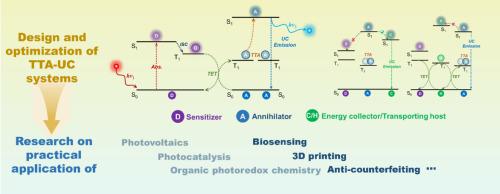面向应用的三重态-三重态湮灭上转换分子设计策略
IF 23.5
1区 化学
Q1 CHEMISTRY, INORGANIC & NUCLEAR
引用次数: 0
摘要
三重态-三重态湮灭上转换(TTA-UC)是通过一系列敏化剂和湮灭剂的光物理过程,在低功率密度激发下将低能光子有效地转化为高能光子。一些经典的ta - uc对已成功应用于光催化、光电、有机光氧化还原化学等领域。然而,分子优化在应用研究中往往被忽视,导致性能提升达不到最优。ta - uc优化与实际实施之间的持续脱节促使本综述弥补了这一关键差距。本文首先分析了TTA-UC对的具体应用要求,并提供了分子选择的设计指南。随后,我们全面回顾了TTA-UC过程中各组分的设计和优化,包括敏化剂的分子分类和实现高效系统间交叉、强吸收和延长三重态寿命的策略;综述了适合特定应用的可调能级湮灭子的研制方法。描述第三个组件的设计原则,并评估其引入后的影响。提供了一个包含多种敏化剂和湮灭剂以供选择的分子文库。此外,本综述系统地研究了新兴的TTA-UC在生物传感、3D打印和防伪方面的应用,强调了分子优化如何决定应用结果。本文综述将为研究人员提供一个全面的视角,从而促进TTA-UC在多学科领域的更广泛实施。本文章由计算机程序翻译,如有差异,请以英文原文为准。

Molecular design strategies for application-oriented triplet-triplet annihilation upconversion
Triplet-triplet annihilation upconversion (TTA-UC) efficiently converts low-energy photons into high-energy photons under low power density excitation via a series of photophysical processes of sensitizers and annihilators. A few classical TTA-UC pairs have been successfully applied to diverse fields such as photocatalysis, photovoltaics, organic photoredox chemistry. However, molecular optimization is often overlooked in applied research, leading to suboptimal performance enhancement. The persistent disconnection between TTA-UC optimization and practical implementation motivates this review to bridge the critical gap. This review first analyzes application-specific requirements for TTA-UC pairs and provides design guidelines for molecular selection. Subsequently, we comprehensively review the design and optimization of various components within the TTA-UC process, including molecular classification of sensitizers and strategies to achieve efficient intersystem crossing, strong absorption, and extended triplet lifetimes; summarize methods for developing annihilators with tunable energy levels and suitable for specific applications; describe design principles of the third component while evaluating their impacts when introducted. A molecular library encompassing diverse sensitizers and annihilators for selection is provided. Furthermore, this review systematically examines emerging TTA-UC applications in biosensing, 3D printing, and anti-counterfeiting, highlighting how molecular optimization dictates application outcomes. This review will offer a comprehensive perspective for researchers, thereby advancing broader implementation of TTA-UC across multidisciplinary fields.
求助全文
通过发布文献求助,成功后即可免费获取论文全文。
去求助
来源期刊

Coordination Chemistry Reviews
化学-无机化学与核化学
CiteScore
34.30
自引率
5.30%
发文量
457
审稿时长
54 days
期刊介绍:
Coordination Chemistry Reviews offers rapid publication of review articles on current and significant topics in coordination chemistry, encompassing organometallic, supramolecular, theoretical, and bioinorganic chemistry. It also covers catalysis, materials chemistry, and metal-organic frameworks from a coordination chemistry perspective. Reviews summarize recent developments or discuss specific techniques, welcoming contributions from both established and emerging researchers.
The journal releases special issues on timely subjects, including those featuring contributions from specific regions or conferences. Occasional full-length book articles are also featured. Additionally, special volumes cover annual reviews of main group chemistry, transition metal group chemistry, and organometallic chemistry. These comprehensive reviews are vital resources for those engaged in coordination chemistry, further establishing Coordination Chemistry Reviews as a hub for insightful surveys in inorganic and physical inorganic chemistry.
 求助内容:
求助内容: 应助结果提醒方式:
应助结果提醒方式:


